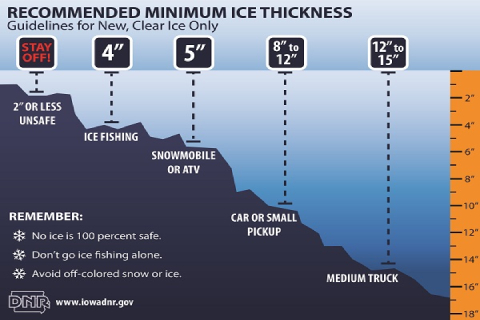By Matt Kelley (Radio Iowa)
With the brutal cold Iowa’s endured this month, our ponds and lakes have developed thick sheets of ice that are providing excellent venues for ice fishing, snowmobiling, cross-country skiing and more.
Joe Larscheid, chief of fisheries at the Iowa Department of Natural Resources, says ice forms at different rates on each body of water, depending on the size and water depth, and he stresses that no ice is ever 100-percent safe.
“Parts of lakes where the snow got swept off the lakes because of the wind, we’re able to produce some really good ice, but anywhere there’s still snow cover, the ice isn’t going to be as thick,” Larscheid says. “This current weather we’re having, especially in southeast Iowa with rain and warm temperatures, it’s going to really weaken conditions.”
Larscheid says new ice is usually stronger than old ice, while river ice is 15-percent weaker than lake ice. The DNR recommends a minimum of four inches of quality ice for fishing and at least five inches for snowmobiles and ATVs. While he likes six inches of ice, Larscheid says many parts of Iowa are reporting it even thicker.
“There’s eight to 10 inches, even 11 inches in some northern Iowa Lakes, and those are the safer locations to be at, but again, even in those lakes with good solid ice, there’s places that are weak,” Larscheid says. “Rocky points, around bridges and things like that, and where there’s snow piled up. A drift of snow can really make for some weak ice underneath the snow.”
He recommends anglers test the ice thickness frequently and to trust your instincts — if the ice doesn’t look right, don’t go out. Ice with a bluish color is safer than clear ice, and Larscheid says to avoid slushy or honey-combed ice, and stay away from dark spots on the ice. So how do you know where to go?
“What I would recommend is, talk to local bait shops, talk to some local anglers, get on our website, look at the fishing reports and we have current ice conditions,” Larscheid says. “Be careful. Look at the thickness and judge if it’s getting weaker. When you’re fishing on a warm, sunny day, I would be a little more cautious than if you’re making ice on a cold day.”
The DNR’s Fishing Report is released every Thursday, with dozens and dozens of ice thickness reports.
Other tips from the agency:
- Don’t go out alone. If the worst should happen, someone will be there to call for help or to help rescue.
- Let someone know where you are going and when you will return.
- Bring along these basic items to help keep you safe: hand warmers, ice cleats to help prevent falls, ice picks (wear around your neck) to help you crawl out of the water if you fall in, a life jacket, a floating safety rope, a whistle to call for help, a basic first aid kit and extra dry clothes including a pair of gloves.




